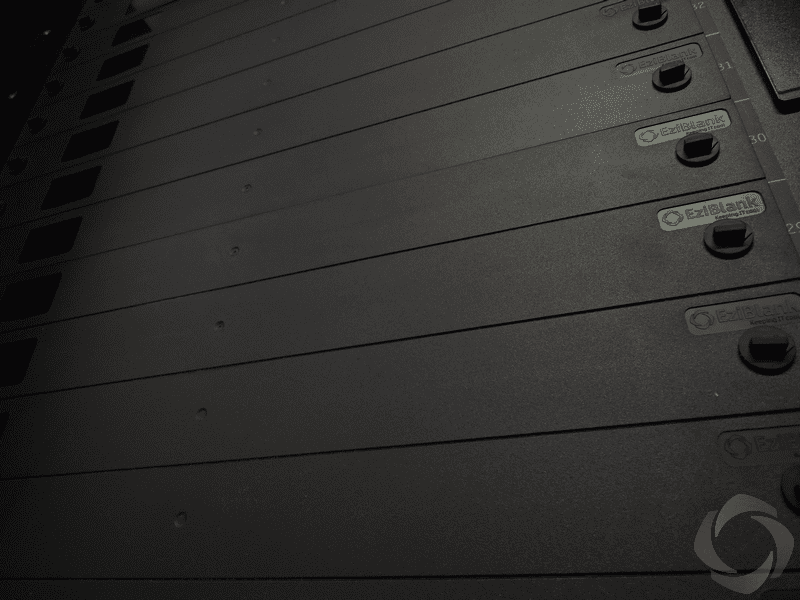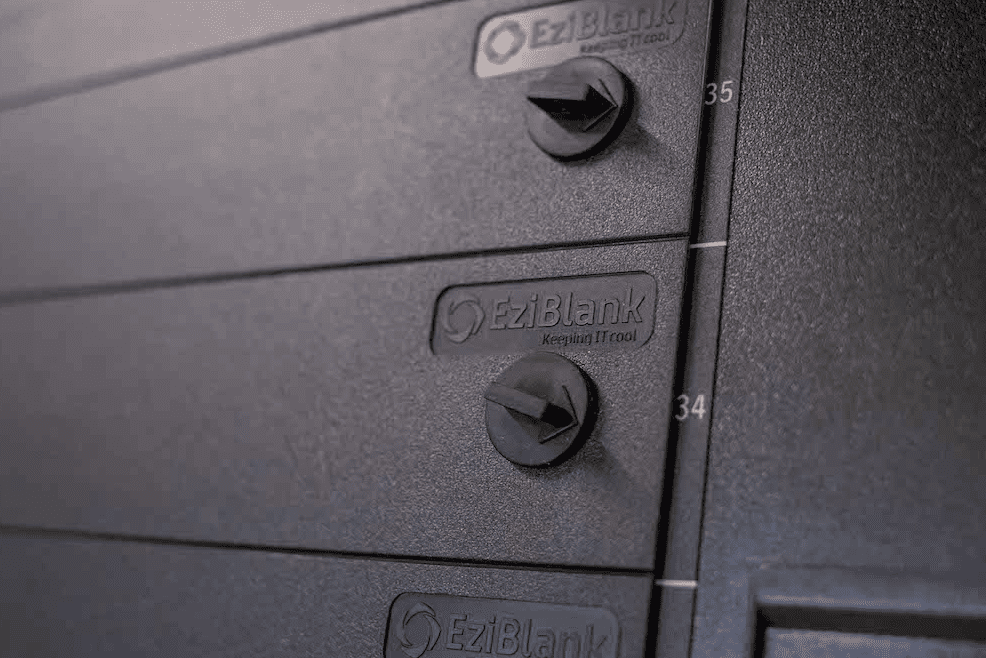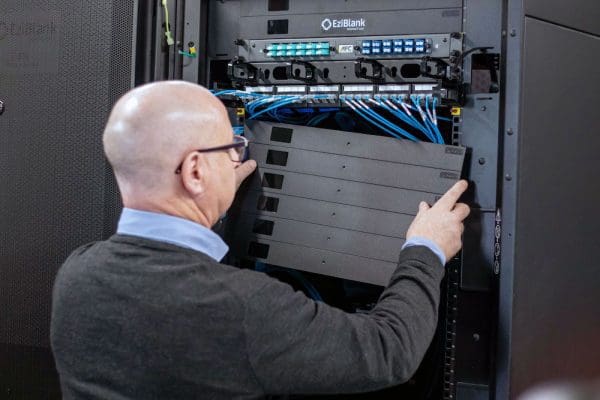As data centers continue to grow in size and complexity, cooling challenges become more critical. Inefficient airflow management can lead to increased energy costs, equipment failures, and potential downtime. Below, we explore five of the most common challenges in data center cooling and explain how EziBlank Blanking Panels, including the innovative EziBlank 6RU and EziBlank 10SU panels, provide solutions that improve efficiency, sustainability, and reliability.
1. Hot Air Recirculation
Hot air recirculation is one of the most common and damaging problems in data center environments. When hot air exhausted from servers re-enters the cold aisle and mixes with cool intake air, it reduces the effectiveness of the cooling system. This forces cooling systems to work harder, driving up energy costs and increasing the risk of equipment overheating. In the long term, hot air recirculation can lead to reduced server performance and premature hardware failure, causing costly downtime. Solving this problem is essential to maintaining both operational efficiency and the longevity of data center equipment, yet many data centers still struggle to fully prevent this airflow imbalance.
How Can EziBlank Stop Hot Air Recirculation?
The EziBlank® 6RU Blanking Panel and EziBlank® 10SU Blanking Panel are designed specifically to prevent hot air recirculation by sealing unused rack space. Made from high-quality flame-retardant ABS plastic, these panels snap securely into place on any EIA-310-D compliant 19” or 21” server racks. The patented snappable design allows the panels to adapt to different RU or SU heights, offering greater flexibility and maintaining proper separation between hot and cold air. This solution prevents hot air from recirculating within racks, optimizing cooling efficiency and reducing the load on cooling systems.
2. Inefficient Hot Aisle/Cold Aisle Containment
Achieving proper hot aisle/cold aisle containment is critical in keeping temperatures within safe operating limits. Poor containment allows cold air to escape into hot aisles or, worse, lets hot air seep back into the cold aisle, causing uneven temperatures across the facility. This not only wastes valuable cooling resources but also leads to the development of hotspots—areas where equipment operates at much higher temperatures than intended. These hotspots increase the likelihood of system malfunctions and can drastically shorten the lifespan of servers and networking equipment. If left unchecked, poor containment can undermine even the most sophisticated cooling systems, leading to frequent maintenance issues and unpredictable performance.
How Can EziBlank Improve Your Containment Strategy?
EziBlank panels provide a robust containment solution. The modular, tool-free mounting system makes it easy to deploy the EziBlank® Blanking Panels quickly and effectively, sealing open spaces between equipment. These panels prevent air mixing, ensuring that cold air is directed to equipment intake areas, while hot air is exhausted without interference. The scratch-resistant textured surface ensures durability in industrial settings, and the panels’ modularity allows for easy adjustment as rack configurations change.
3. Inconsistent Rack Densities and Underutilized Space
Not every rack in a data center is always fully populated, and inconsistent rack densities present a challenge for maintaining efficient cooling. Unused rack spaces act as gaps that allow cold air to pass through without effectively cooling active equipment. Meanwhile, racks with denser configurations may not receive enough cooling, leading to uneven temperature distribution and the development of hot spots. This imbalance often causes cooling systems to work inefficiently, with cooling resources being wasted on empty spaces while high-density racks risk overheating. Inconsistent rack densities complicate airflow management, particularly in dynamic environments where equipment is frequently added or removed.
How Can EziBlank Help Optimize Rack Density Cooling?
The EziBlank® 6RU Blanking Panel and 10SU Blanking Panel address this challenge by filling in the unused space in racks. These panels snap into place without tools, providing an immediate solution to gaps that would otherwise allow air to mix. Their patented snappable design makes them adaptable to different RU and SU heights, meaning they can be adjusted and reused as data center needs evolve. By ensuring airflow is directed only to active equipment, EziBlank panels eliminate inefficient airflow, improving overall cooling effectiveness.
4. High Energy Costs Due to Inefficient Cooling
Cooling is one of the most significant energy expenses in data centers, accounting for up to 40-50% of the total energy consumption. When airflow is not properly managed, cooling systems have to run longer and harder to maintain desired temperatures. Inefficiency in cooling not only leads to wasted energy but also inflates operational costs, putting pressure on data center operators to find more sustainable solutions. Data centers are constantly seeking ways to reduce their carbon footprint, and inefficient cooling practices directly counter these efforts. Improving airflow management is one of the most effective ways to cut energy costs, but many facilities are slow to adopt the necessary changes.
Can EziBlank Reduce Your Energy Bills?
EziBlank products are designed to reduce energy consumption by optimizing airflow. By using recyclable lightweight plastic that is both durable and environmentally friendly, the EziBlank® Blanking Panels offer a long-term sustainable solution. These panels help data centers avoid overcooling by ensuring cool air reaches only the necessary components, thereby lowering the overall cooling load. The result is reduced energy consumption and lower cooling costs, all while maintaining the performance and reliability of critical equipment.
5. Difficult Retrofitting in Legacy Data Centers
Many older data centers weren’t designed with the advanced airflow management systems that modern data centers use today. As a result, retrofitting legacy data centers for better cooling efficiency can be a daunting task. These facilities often face significant compatibility issues, with older infrastructure not suited for newer airflow management solutions. The challenge lies in finding solutions that can be integrated into existing setups without causing major operational disruptions or requiring expensive overhauls. For many operators, upgrading cooling systems in legacy facilities feels like a significant investment in time and resources. However, without addressing the cooling inefficiencies, these data centers risk falling behind in performance and sustainability.
Can EziBlank Be Easily Retrofitted in Existing Data Centers?
One of the key advantages of the EziBlank® Blanking Panels is their universal, tool-free mounting system, making them ideal for retrofitting older data centers. These panels are compatible with any EIA-310-D compliant 19” or 21” server rack, and their moulded positioning studs ensure perfect alignment during installation. The lightweight and modular nature of the panels makes them easy to install and remove without disrupting operations, offering a cost-effective solution for legacy data centers looking to improve airflow and cooling efficiency.
How EziBlank Solves Data Center Cooling Challenges
By addressing critical airflow management issues such as hot air recirculation, inefficient containment, and high energy costs, EziBlank® Blanking Panels play a crucial role in optimizing data center cooling. Their modular design, robust flame-retardant ABS plastic, and ease of installation make them an ideal solution for both modern and legacy data centers.
EziBlank products help data centers achieve better energy efficiency, reduce cooling costs, and maintain optimal operating temperatures, all while providing flexible and durable solutions that can adapt to changing data center needs. Investing in EziBlank’s innovative products is a forward-thinking step toward maximizing data center performance and ensuring long-term operational sustainability.



